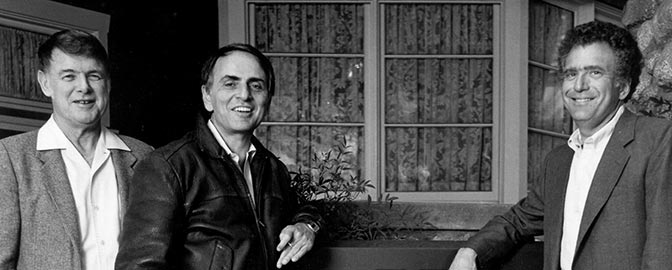Scientists from Different Fields Line Up to Join the BOINC Family

Written by
Amir Alexander
Writer and Editor for planetary.org
August 24, 2004
On Tuesday, June 22, 2004, with little fanfare, the new BOINC-based version of SETI@home was released to the general public. As those of you who have been following our Updates know, BOINC stands for the “Berkeley Online Infrastructure for Network Computing.” Its purpose is to spread the credo of distributed computing beyond SETI@home, by making it easy for researchers in all fields to launch their own projects, and tap into the enormous computing capacity of personal computers around the world.
First in line of the BOINC projects is, of course, SETI@home itself, which serves as the model and prototype for the entire project. Over the next few months, the new BOINC-based SETI@home will run side by side with Classic SETI@home, and users can choose to run either one or the other. Once project director David Anderson and his team are confident that the new version can reliably take the load, Classic SETI@home will be turned off and BOINC-based SETI@home will continue on its own, searching for intelligent signals from the stars.
In most ways, the new project will feel very familiar to veteran SETI@home users. Fresh work units are still being sent regularly from Berkeley to users’ home computers just as they are on Classic SETI@home, and processed data is still sent back as usual. The screen graphics, of which there are several versions for BOINC users, are still unmistakably “SETI@home” in look and style. But in other ways BOINC will offer subtle but important changes to longtime users. Instead of the standard fixed size-work units, work assignments to different computers will now vary in size, depending on the computer’s capacity. Because of this, users’ credits will not be counted simply as the number of work units they completed, but the amount of actual calculation completed by each computer.
In addition, BOINC will offer SETI@home a degree of flexibility that is not possible in the current set-up: rather than being limited to the uniform work units originating at the Arecibo receiver, BOINC SETI@home can be easily adjusted to process data from different receivers at different frequencies and band-width. Finally, as part of a fast growing family of BOINC projects, the new SETI@home will offer users the opportunity to process data from other scientific projects and decide for themselves how much of their computer time t devote to each topic. For those of us dedicated to using our personal computers to search for intelligent beings in the universe, BOINC is a giant leap forward.
As is often the case with the launch of groundbreaking new technologies, not everything went smoothly. On June 29 the program managing the project’s database overloaded, and the BOINC website was taken off-line for a day for some much needed upgrades. “This is not surprising” said David Anderson, who leads both the BOINC and SETI@home projects. “Looking back on the launch of SETI@home five years ago, we had similar problems at the time.” “BOINC,” he added “does a great deal more than SETI@home,” and it should be expected that it would take a while before all parts of this complicated system run smoothly. “When we launched SETI@home in 1999 the system crashed within a few hours” added Matt Lebofsky, who works with Anderson on both Classic SETI@home and BOINC. “This time it took a whole week.”
We all know that SETI@home’s early troubles did not prevent it from becoming wildly successful, and the largest computing network ever assembled. There is every reason to expect that the same will be true of BOINC as well: already half a dozen research groups in fields ranging from climatology to astrophysics are lining up to launch their own BOINC distributed computing projects.
Furthest along in the process is a team of biophysicists who on June 4 launched their BOINC-based program predictor@home. Its purpose is to assist scientists in predicting the structure of proteins, a capacity that is of critical importance in designing effective new drugs. Proteins, explained project leader Charles Brooks of the Scripps Research Institute in San Diego, are composed of strings of over 100 amino acids. Each amino acid, said Brooks, can be positioned in several different ways in 3-dimensional space, leading to an almost unlimited range of possible protein structures. The enormous calculating capacity of BOINC will be harnessed to sift systematically through the innumerable possible variations and arrive at the protein structure most likely to be correct. Since going online on June 4, said Brooks, the project has been growing fast and already has around 8000 participants using 30,000 computers.
The scientific value of predictor@home will be tested soon. Brooks and his team are currently participating in an international experiment known as CASP6 - the sixth Critical Assessment of Structure Prediction. In CASP, the amino acids sequences of unknown proteins are presented to different groups of researchers, challenging them to determine the actual structure of the protein in question. By next fall the results will be in, and it will be clear how effective predictor@home has been in sifting through the almost limitless possibilities and arriving at the protein’s true structure. Not only Brooks and his colleagues, but all of the BOINC universe, is eagerly awaiting the outcome.
While predictor@home is already online, other projects are currently gearing up to join the BOINC family. Climateprediction.net is an integrated computing project based at Oxford University in England, dedicated to studying models of climate change. To do this, the project sends different sets of slightly different data to different users, who then process the information in accordance with the given model, predicting the long-term effects on the climate. The range of outcomes that result from the slightly different initial suppositions provides scientists with important insights on the value and reliability of their model. Climateprediction.net has been operating as an independent distributed computing projects for several years, and already has 62,000 participants in 130 countries. Now, however, it is in the process of transitioning to BOINC, and will launch its new BOINC-based software on August 26. From that day on, said Anderson, BOINC users will be able to process models of climate change on their home computers.
In a previous update we have already reported on the exciting scientific results from folding@home. Like climateprediction.net, folding at home is an ongoing independent distributed computing project, and like predictor@home it is concerned with the folding of proteins. But whereas predictor@home is concerned with determining the likely final structure of proteins, folding@home focuses on analyzing the mechanics of the folding process. Folding at home is currently in the process of converting from its independent format to the BOINC platform, a process that according to Anderson will take a few more months.
A relative newcomer to BOINC, Einstein@home is a BOINC project that investigates the fundamental structure of time and space in the universe. It is part of the giant LIGO project – the Laser Interferometer Gravitational Wave Observatory – whose purpose is to directly measure gravitational waves in the universe. According to Einstein’s General Theory of Relativity, gravitational waves are created by massive alterations in the concentrations of mass in the universe, which cause distortions in the fabric of space and time that propagate at the speed of light. With BOINC-users’ help, Einstein@home will process masses of data collected by the two LIGO observatories, in search of gravitational waves emanating from pulsars. Anderson estimates that this project will be ready to join the BOINC family within a year.
Scientists at CERN, the famous European particle physics laboratory located near Geneva, Switzerland, are also working to join the BOINC family. The main CERN accelerators are circular tubes, several kilometers in length, surrounded by powerful superconducting magnets that bend the path of sub-nuclear particles traveling at close to the speed of light. When designing their experiments, CERN physicists need to calculate the exact locations in which to place the powerful to guide the particles in their proper course. By designing their own BOINC program, they will be able make these calculations faster and with greater accuracy, leading to improved and more efficient experiments.
Finally, Astropulse BOINC is not really an independent project, but an extension of SETI@home itself. Run by David Anderson’s and Chief Scientist Dan Werthimer’s group in Berkeley, Astropulse will process the data from the SETI@home sky survey in search of electromagnetic pulses that signify the “dying gasps” of black holes. According to Lebofsky, Astropulse will open to the public participation later this summer.
With two programs already online, and half a dozen others waiting in the wings, BOINC is off to a fast start. Once it resolves its initial growing pains, which are an inevitable part of any innovative ambitious project, BOINC has the potential of transforming the way scientists in all fields conduct complex calculations. SETI@home may not yet have found intelligent aliens in outer space, but it is already transforming the scientific landscape here on Earth.
Support our core enterprises
Your gift today will go far to help us close out the year strong and keep up our momentum in 2026.
Donate

 Explore Worlds
Explore Worlds Find Life
Find Life Defend Earth
Defend Earth

